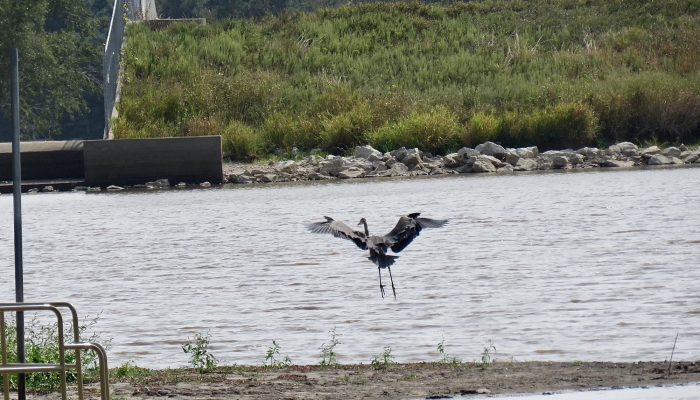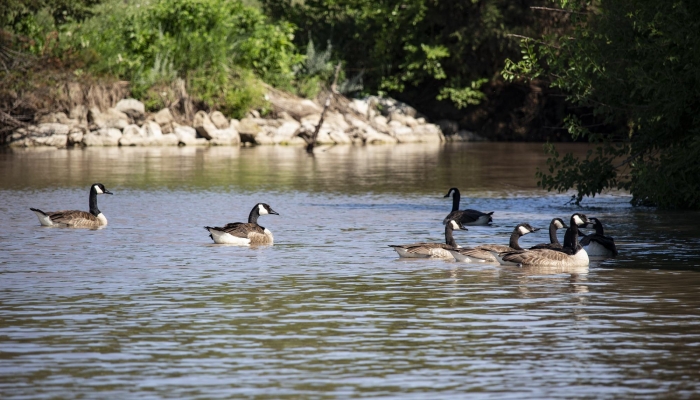Recharge Lake, local gem for wildlife enthusiasts, has a long history
Bruce L. Anderson Recreation Area in York features a 44-surface-acre lake where locals can go RV and tent camping, boating, fishing, hiking, birding and more. But what’s the story with the man whose name is on the rec area, and why is the lake better known simply as Recharge?
The rec area was created and is managed by the Upper Big Blue Natural Resources District. John Turnbull, who served as general manager of the Upper Big Blue NRD from 1978 to 2016, recalled the origin of the project. It began with a research grant from the federal government. In the late 80s, the U.S. Bureau of Reclamation wanted to fund 21 projects in western states to look at issues around groundwater recharge (how much water from the surface reaches the below-ground water supply and how quickly does it get there?). This is vital information to agriculture-dependent states like Nebraska, where the health and wealth of all residents is linked to the groundwater supply.
Nebraska Senator Doug Bereuter lobbied for some of these studies to take place in his home state. Two locations in Nebraska were selected—one in York and one near Grand Island. The project provided 80 percent of the funds necessary to acquire the lands and build the structures.
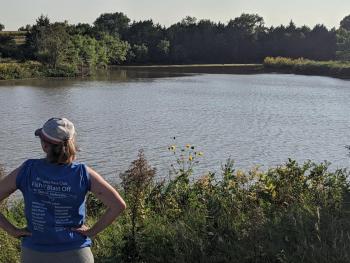 In 1990, the dam was constructed that created Recharge Lake (so named because it was used to study the groundwater recharge rate) in what was previously a pasture. York resident Jay Bitner, who served as the NRD Projects Department Manager for more than 30 years, oversaw the construction of the facility. He was assisted by Jeff Ball, who has worked as the NRD lead engineering technician for more than 40 years. Bitner and Ball also directed construction of observation wells and recharge basins around the lake as part of the study.
In 1990, the dam was constructed that created Recharge Lake (so named because it was used to study the groundwater recharge rate) in what was previously a pasture. York resident Jay Bitner, who served as the NRD Projects Department Manager for more than 30 years, oversaw the construction of the facility. He was assisted by Jeff Ball, who has worked as the NRD lead engineering technician for more than 40 years. Bitner and Ball also directed construction of observation wells and recharge basins around the lake as part of the study.
Over a five-year period, the NRD team measured the inflow and outflow of water from the lake and the basins and their impact on groundwater. They also used the lake to study agrochemical runoff impacts on groundwater quality, and whether or not water collected in the lake could be remediated for chemicals (such as atrazine) and re-injected into the groundwater supply.
Turnbull recalled that the lake had higher rates of groundwater recharge in the beginning of the study, but as silt washed in from the more than 8,000 acres that drain to the location, the lake bottom eventually sealed more, slowing the rate of recharge. This was of benefit for the water quality issue, as the sediment on the lake bottom acted like a filter, preventing much of the collected atrazine from entering the groundwater supply.
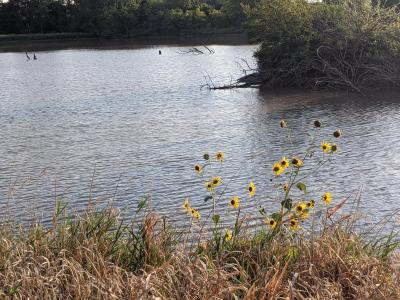 Water quality remains a concern as sediments from within the watershed continue to travel into Recharge Lake. The NRD is currently devoting resources to address water quality in Recharge Lake by working with landowners in the watershed area. This group of key stakeholders are collaborating on best management practices to prevent additional sediments from entering the lake in the future.
Water quality remains a concern as sediments from within the watershed continue to travel into Recharge Lake. The NRD is currently devoting resources to address water quality in Recharge Lake by working with landowners in the watershed area. This group of key stakeholders are collaborating on best management practices to prevent additional sediments from entering the lake in the future.
The plan from the beginning was to make Recharge a dual-purpose project, with the twin aims of research and recreation, said Turnbull. Once the research component was off and running, the NRD began to improve the area surrounding the new lake for a rec area. It has been a slow process over the last 30 years as the NRD has regularly added more amenities to the facility. Today, it is used by thousands of people each year. During the summer months, the campgrounds are in especially high demand, as they offer a low-cost camping option in a serene setting. Due to the pandemic making indoor events less desirable, the amphitheater and picnic shelters have also seen much use this summer.
In addition to its other uses, Anderson Recreation Area provides essential habitat for many varieties of birds, fish, reptiles, insects, and mammals.
Bruce L. Anderson’s name was affixed to the recreation area after his death in 1996. Anderson was a farmer and lifelong conservationist from Stromsburg, who started the Polk County Soil and Water Conservation District in 1944. This group later became part of the Nebraska Natural Resources Districts when they were created in 1972. Anderson sat on the board of the Polk County Soil and Water Conservation District and then the Upper Big Blue NRD for a total of 50 years. His farm practices and conservation activities earned him a conservation award from Polk County in 1963. In 1983, he was named a Master Conservationist by the Omaha World-Herald. His long service to the NRD and decades of commitment to the stewardship of natural resources led to his name being attached to the recreation area in York.
More information on camping and amenities at Anderson Recreation Area and the other four rec areas managed by the Upper Big Blue NRD at www.upperbigblue.org/recreation.
A local man enjoys kayaking on the lake on a chilly morning in October.
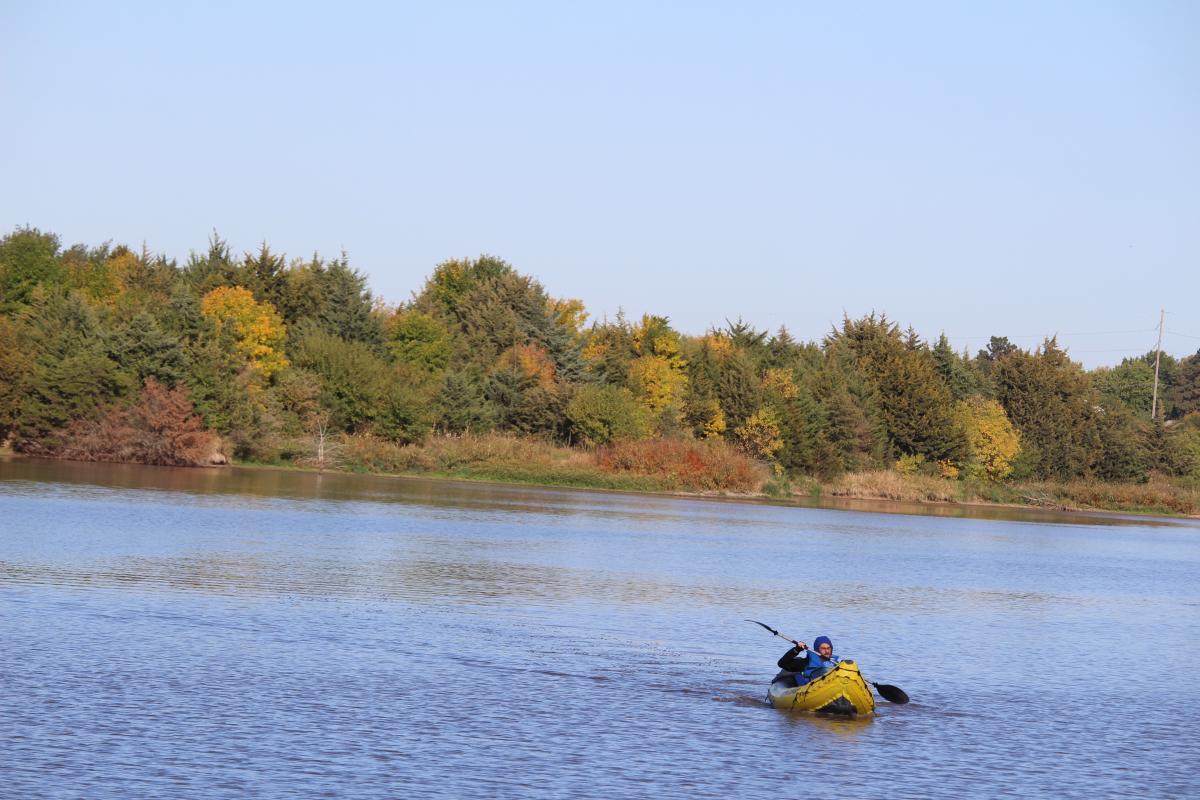
The rec area was created and is managed by the Upper Big Blue Natural Resources District. John Turnbull, who served as general manager of the Upper Big Blue NRD from 1978 to 2016, recalled the origin of the project. It began with a research grant from the federal government. In the late 80s, the U.S. Bureau of Reclamation wanted to fund 21 projects in western states to look at issues around groundwater recharge (how much water from the surface reaches the below-ground water supply and how quickly does it get there?). This is vital information to agriculture-dependent states like Nebraska, where the health and wealth of all residents is linked to the groundwater supply.
Nebraska Senator Doug Bereuter lobbied for some of these studies to take place in his home state. Two locations in Nebraska were selected—one in York and one near Grand Island. The project provided 80 percent of the funds necessary to acquire the lands and build the structures.
 In 1990, the dam was constructed that created Recharge Lake (so named because it was used to study the groundwater recharge rate) in what was previously a pasture. York resident Jay Bitner, who served as the NRD Projects Department Manager for more than 30 years, oversaw the construction of the facility. He was assisted by Jeff Ball, who has worked as the NRD lead engineering technician for more than 40 years. Bitner and Ball also directed construction of observation wells and recharge basins around the lake as part of the study.
In 1990, the dam was constructed that created Recharge Lake (so named because it was used to study the groundwater recharge rate) in what was previously a pasture. York resident Jay Bitner, who served as the NRD Projects Department Manager for more than 30 years, oversaw the construction of the facility. He was assisted by Jeff Ball, who has worked as the NRD lead engineering technician for more than 40 years. Bitner and Ball also directed construction of observation wells and recharge basins around the lake as part of the study.Over a five-year period, the NRD team measured the inflow and outflow of water from the lake and the basins and their impact on groundwater. They also used the lake to study agrochemical runoff impacts on groundwater quality, and whether or not water collected in the lake could be remediated for chemicals (such as atrazine) and re-injected into the groundwater supply.
Turnbull recalled that the lake had higher rates of groundwater recharge in the beginning of the study, but as silt washed in from the more than 8,000 acres that drain to the location, the lake bottom eventually sealed more, slowing the rate of recharge. This was of benefit for the water quality issue, as the sediment on the lake bottom acted like a filter, preventing much of the collected atrazine from entering the groundwater supply.
 Water quality remains a concern as sediments from within the watershed continue to travel into Recharge Lake. The NRD is currently devoting resources to address water quality in Recharge Lake by working with landowners in the watershed area. This group of key stakeholders are collaborating on best management practices to prevent additional sediments from entering the lake in the future.
Water quality remains a concern as sediments from within the watershed continue to travel into Recharge Lake. The NRD is currently devoting resources to address water quality in Recharge Lake by working with landowners in the watershed area. This group of key stakeholders are collaborating on best management practices to prevent additional sediments from entering the lake in the future. The plan from the beginning was to make Recharge a dual-purpose project, with the twin aims of research and recreation, said Turnbull. Once the research component was off and running, the NRD began to improve the area surrounding the new lake for a rec area. It has been a slow process over the last 30 years as the NRD has regularly added more amenities to the facility. Today, it is used by thousands of people each year. During the summer months, the campgrounds are in especially high demand, as they offer a low-cost camping option in a serene setting. Due to the pandemic making indoor events less desirable, the amphitheater and picnic shelters have also seen much use this summer.
In addition to its other uses, Anderson Recreation Area provides essential habitat for many varieties of birds, fish, reptiles, insects, and mammals.
Bruce L. Anderson’s name was affixed to the recreation area after his death in 1996. Anderson was a farmer and lifelong conservationist from Stromsburg, who started the Polk County Soil and Water Conservation District in 1944. This group later became part of the Nebraska Natural Resources Districts when they were created in 1972. Anderson sat on the board of the Polk County Soil and Water Conservation District and then the Upper Big Blue NRD for a total of 50 years. His farm practices and conservation activities earned him a conservation award from Polk County in 1963. In 1983, he was named a Master Conservationist by the Omaha World-Herald. His long service to the NRD and decades of commitment to the stewardship of natural resources led to his name being attached to the recreation area in York.
More information on camping and amenities at Anderson Recreation Area and the other four rec areas managed by the Upper Big Blue NRD at www.upperbigblue.org/recreation.
A local man enjoys kayaking on the lake on a chilly morning in October.


